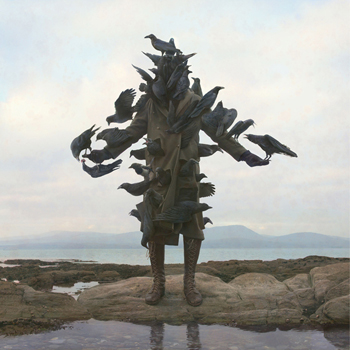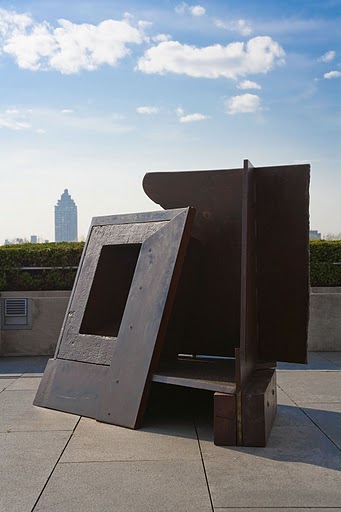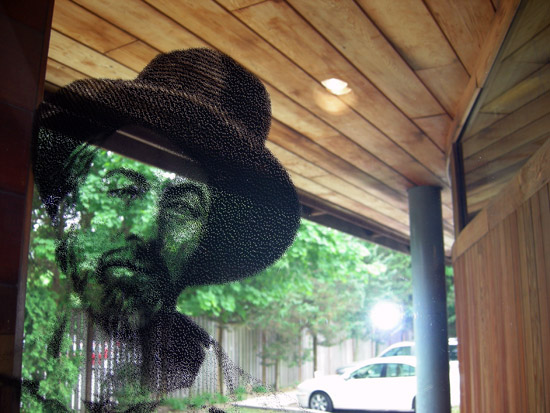At the heart of the interdisciplinary, experimental approach to art making documented in “Black Mountain College and Its Legacy” at the Loretta Howard Gallery, is a human ethology that emphasizes cooperation and interdependence. What happened at Black Mountain College is as nostalgic as it is antithetical to western society’s preoccupation with the importance of the individual over the group, most recently highlighted with the passing of Apple’s visionary icon earlier this month.
Posts by Gabriella Radujko
Black Mountain College and Its Legacy @ Loretta Howard Gallery
by Gabriella Radujko on October 24th, 2011
Detroit Disassembled @ Queens Museum of Art
by Gabriella Radujko on September 28th, 2011

Andrew Moore, House on Walden Street, East Side, 2008, Digital chromogenic print scanned from film negative
Andrew Moore’s must see photographs in Detroit Disassembled at the Queens Museum of Art capture the ruinous state of Detroit after the collapse of the automotive industry. The colors are lush, the light, ecclesiastical; and Moore captures the intensity prescribed by Frederick H. Evans who urged photographers to “wait till the building make you feel intensely”.
To-dos @ the Morgan Library
by Gabriella Radujko on September 10th, 2011
It is hard to believe that the 1913 New York Armory Show took place less than 100 years ago. The seminal show drew laughs for its paintings and denunciations for their degeneracy, while the medium of photography, facilitated by Alfred Stieglitz, was inaugurated as a new art form, acceptable only as measured by proximity to the extreme paintings and sculptures on exhibit.
It is Picasso’s list of suggested artists for inclusion in the show, dated 1912, that makes a case for the subtleties that make this Morgan sleeper, “To-dos, Illustrated Inventories, Collected Thoughts, and Other Artists’ Enumerations from the Smithsonian’s Archives of American Art”, a must-see for anyone interested in art history or contemporary art or both. Through curatorial acumen, its 80 lists simultaneously remind us how different yet familiar at the same time the world is today from the one reflected in the exhibit.
Beautiful Vagabonds @ Yancey Richardson Gallery
by Gabriella Radujko on August 9th, 2011

Yancey Richardson Gallery signaled appreciation for the naturalist John Burroughs by naming the summer group show Beautiful Vagabonds, the writer’s poetic keywords for birds. Few works exemplified a naturalist’s approach to photography, however, demonstrating fitting curatorial restraint for a subject-based show intent on catholicity. Among them Sustenance #114 by Neeta Madahar, Policeman by Jitka Hanzlová, American Goldfinches by Paula McCartney, and Terry Evans’ Field Museum, Drawer of Eastern Meadowlarks, works corresponding to what one would see in a natural history museum.
Mythopoeic LANY Group Show at Peter Blum Gallery in Chelsea
by Gabriella Radujko on July 19th, 2011

LANY, pronounced L. A. New York, is the high functioning group show at Peter Blum Gallery in Chelsea where seven artists from both cities have ample space to show their work. The non-thematic (beyond bi-coastal geography) show, organized by Mario Diacono includes work by New York-based Daniel Rich, Andy Cross and Benjamin Degen and Los Angeles-based Kara Tanaka, James Melinat and Kevin Appel. There is also a show within a show by New York-based Luisa Rabbia.
Anthony Caro on the Roof
by Gabriella Radujko on May 17th, 2011

Spring in New York is a brief and uncertain period according to the Green Michelin Guide, but the weather held for the preview of “Anthony Caro on the Roof” at the Metropolitan Museum of Art on April 25. The five, large-scale steel sculptures are typical of his work, with characteristic use of ground plane and prefabricated steel sections. The English sculptor, 87, spoke to press, friends and admirers, in the midst of his playfully arranged works. “I am very thrilled”, he said, no doubt referring to how supremely suited they were to the expansive Cantor Roof Garden, framed, no less, by blossoming trees in Central Park.
George Wallace talks to Claudia Serea
by Gabriella Radujko on March 29th, 2011

Having followed the poetry scene on both sides of the Hudson for years, it was inevitable that I would come to know the poets paired for this interview. In 2010, I met George Wallace at the Bowery Poetry Club where he was host for that Sunday afternoon’s reading. I immediately appreciated the excitement he generated and the encouragement he offered to the features and those, like me, who would participate in open mic. I met Romanian-born poet Claudia Serea at the Williams Center in Rutherford, New Jersey in 2010. There, I was surrounded by poets who would eventually offer to publish her work and mine in the same Red Wheelbarrow anthology that year. When I learned that the two poets knew each other too, they became perfect candidates for the artist-to-artist interview series. Claudia would ask George to decode poetryland and George would oblige, revealing a mindfulness about poetry that straddles high and low culture, emphasizing the roles of plurality, craftsmanship and discovery.
George Wallace is the 2011 Writer-in-Residence at the Walt Whitman Birthplace. He is currently on tour promoting Walt Whitman and Beyond—Fanfares for the Common Man both stateside and overseas. He is the author of 19 chapbooks of poetry, professor at Pace University in New York, a well-known and highly regarded poetry promoter. Here, he is interviewed by Romanian-born poet Claudia Serea whose work and translations have appeared in Exquisite Corpse, Mudfish and 5 a.m. and is the author of two poetry collections.



 RSS
RSS
